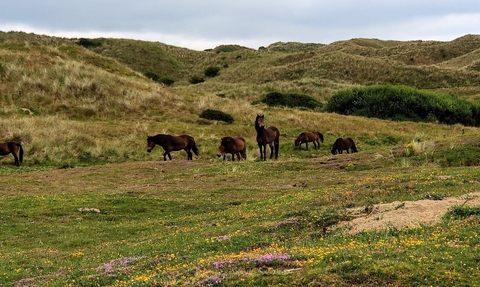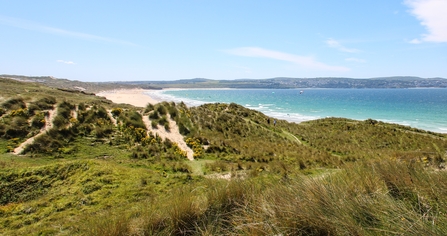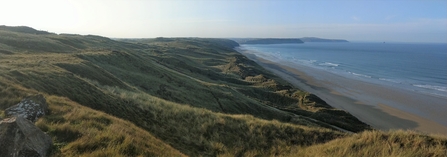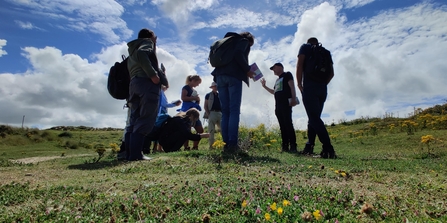
Ponies can help dune habitat diversity by grazing some areas
Dynamic Dunescapes
Thank you
Thank you for following our work on the Dynamic Dunescapes project in Cornwall. Unfortunately, our engagement work has now come to an end, so this page will no longer be updated. However, we will continue to manage sand dunes for wildlife and so that people can continue to enjoy these amazing places.
What is Dynamic Dunescapes?
Dynamic Dunescapes is a partnership project, restoring sand dunes across England and Wales for the benefit of wildlife, people and communities. In Cornwall the project is being delivered by Cornwall Wildlife Trust at two different sand dune systems: Penhale Dunes near Perranporth and The Towans, near Hayle. The project is funded by the National Lottery Heritage Fund and the EU LIFE Programme and delivered alongside various project partners including the Towans Partnership and Friends of The Towans.
Emmeline Hardisty explores Upton Towans nature reserve with Cornwall Wildlife Trust's People Engagement Officer for the Dynamic Dunescapes project Andy Nelson
What’s the problem?
The coastal dunes of England and Wales are internationally important habitats for wildlife, listed as one of the most threatened environments in Europe for biodiversity loss. Cornwall’s dunes are home to a wide variety of wildlife, including rare plants such as petalwort, early gentian, shore dock and Babington’s leek, as well as several insects that burrow into sand to make their nests. But conventional dune management over many decades has meant that dunes have become overgrown with thick vegetation, including several invasive species, and over-stabilised. We now know that healthy dune systems contain a variety of habitats, including areas of bare sand which is free to move, continuously recreating dynamic dunescapes.

The Towans sand dunes cover an extensive area of St Ives Bay
What is the project doing about this?
Many species, including a variety of burrowing insects, need areas of open sand to thrive, so this project is bringing life back to the dunes by creating more of these areas. We’re doing this by removing layers of soil and vegetation mechanically in a process known as turf stripping.
Dune slacks are seasonally wet dips in the dunes, which makes them important habitat for some of our rarest dune plants. We are enhancing these by removing excess shrubs and scraping away surface layers of organic matter, to encourage specialised dune slack plants, such as shore dock, to thrive.
Subject to relevant permissions, we plan to use heavy machinery to create several large V-shaped notches in carefully chosen areas of the foredunes. These notches rejuvenate old blowouts, by allowing sand to blow up from the beach and into the dunes behind, making these areas more dynamic again.
Invasive species, including garden escapees, are being removed from the dunes, to improve conditions for rare native plants to flourish. Also, grazing animals, such as ponies and cattle, are being used to increase dune health; by munching on plants in some areas they help to maintain a diverse mosaic of habitats. We are also encouraging responsible use of these beautiful areas.

We work with various landowners at Penhale Dunes, including the Ministry of Defence and Perran Sands Holiday Park
What are the Project Objectives?
- To deliver direct evidence-based management and interventions on project sites that will make a demonstrable and sustainable improvement for the conditions and processes needed to support dune habitats and species.
- To build an understanding and appreciation of sand dunes as a naturally dynamic habitat requiring conservation interventions.
- To ensure more people and a wider range of people are involved with sand dunes and through their involvement learn about, enjoy and value sand dunes.
- To develop the skills of individuals and organisations to better manage dunes both now and in the future.
- To establish strong networks so that lessons learnt from the project (both conservation and people engagement) are shared and disseminated, building a lasting legacy for sand dunes.
How can I get involved?
We spoke with people at the start of the project and discovered that here is a clear appetite to learn more about the plants and animals that live on sand dunes. There is also a willingness to get involved in looking after sand dunes and their associated wildlife. In Cornwall, our project is working in a variety of ways to engage with local people, including:
⦁ working with local schools, to support use of the dunes for outdoor learning
⦁ supporting Cornwall Dunes Recording Group: a group of volunteers being trained in wildlife identification and recording techniques
⦁ delivering practical conservation work, such as scrub clearance, by working with volunteers
⦁ building connections with regular site users, such as dog walkers, to discuss how they can help dune wildlife
⦁ supporting local colleges and universities to run field trips on the dunes and encourage dune-focused student research
⦁ organising events and art workshops in and about the dunes to encourage people to explore and protect this wonderful habitat

Cornwall Dunes Recording Group on a botany workshop
Cornwall Dunes Recording Group
One great way for you to help dune wildlife is to join our Cornwall Dunes Recording Group. We're running species identification workshops and wildlife surveys at both our project sites, to help people get better at recording our wonderful dune wildlife. These species records are vitally important as they show where the different plants and animals are found in the dunes and how their distribution is changing over time. This helps site managers to make better decisions on how to mange their sites, for the benefit of wildlife both now and in the future.
Join Cornwall Dunes Recording Group on Facebook
Watch and learn how Pip Cook, one of our engagement team, created illustrations of sand dune invertebrates using ink, parsnips, and charcoal! You can download a free pdf of her booklet below...
Download our free sand dune invertebrates booklet
Contact
Contact Andy Nelson, our Engagement Officer, via email to find out more about events and opportunities to get involved.







